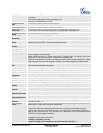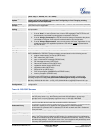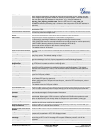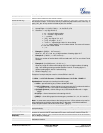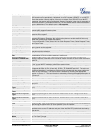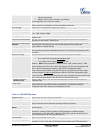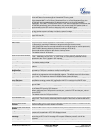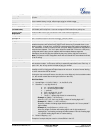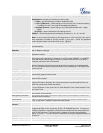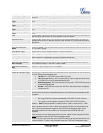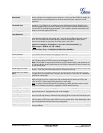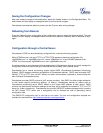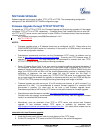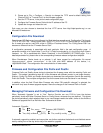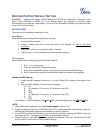
Grandstream Networks, Inc. HT503 User Manual Page 34 of 38
Firmware 1.0.4.2 Last Updated: 06/2011
Enable Current
Disconnect
Default is Yes. This value should be used in case the PSTN provider uses line power
drop to indicate call completion to the end point. In this case the HT503 will search for
a power drop for a preconfigured time frame to disconnect such calls from a VoIP
extension.
Current Disconnect
Threshold (ms)
This is a preconfigured value of duration for a line power drop used by specific service
providers. For example, for a configured value of 500ms the device will ignore any
random voltage drops on the line if duration of such drop is less than 500ms and the
call will NOT be considered as terminated. This is useful to prevent unnecessary call
drops in some low quality PSTN lines.
Enable PSTN Disconnect
Tone Detection
If set to Yes, arrived Busy Tone is used as the disconnect signal.
PSTN Disconnect Tone
In certain countries, the central office will send a special busy tone to indicate when a
call is disconnected from the remote side. User can pre-configure this tone on the
ATA. The user should know the frequency values and cadences of these tones.
Here is an example for the syntax for a busy tone in the U.S.A:
(Syntax: f1=freq@vol, f2=freq@vol, c=on1/off1-on2/off2-on3/off3; [...])
(Note: freq: 0 - 4000Hz; vol: -30 - 0dBm)
(Default: Busy Tone - f1=480@-24,f2=620@-24,c=500/500;)
AC Termination Model
You can select the AC termination by Country or by Impedance.
Country-Based
15 Countries are selectable in this version of the F/W.
Impedance-Based
Select the Impedance used by the PSTN service provider.
Number of Rings Default is 4. This setting specifies number of phone rings (on the phone connected to
the FXS port) before a PSTN incoming call is bridged to VoIP
Note: The number of rings feature serves as a PSTN answer delay, and should be set
to a larger value to allow enough time for the HT503 to decode the Caller ID signal set
by the central office.
PSTN Ring Thru FXS
If Yes, the phone connected to the FXS port will ring a configured amount of times (see
above). If not, the phone connected to the FXS port will not ring.
PSTN Ring Thru Delay
(sec)
If the PSTN Ring Thru Delay is set to Yes, all incoming PSTN calls through FXO will
ring the phone connected to the FXS port, after this delay or after caller id is detected
(whichever comes first).
DTMF Digit Length (ms)
Digit length and Dial Pause are port digit dialing configurations; FXO needs to dial out
digits for VOIP to PSTN 1 stage calls, and unconditional call forward to PSTN, and
route to PSTN. Digit Length is the play time for each digit.
Note: In order to receive the caller ID information, the delay should be set to a value
larger than the delay required to complete the PSTN caller ID delivery.
DTMF Dial Pause (ms)
Dial pause is the time between 2 digits for the same scenario as explained above.
First Digit Timeout (sec)
Used for PSTN to VoIP calls. PSTN users need to enter the FIRST digit within the first
digit timeout period. Otherwise the call will be dropped.
Inter Digit Timeout
When dialing from the PSTN to VoIP, subsequent digits have to be input within the
period of inter-digit timeout. Otherwise the dial plan thinks it is the end of the digit input.
Wait for Dial Tone
Wait for Dial tone is used for one stage VoIP to PSTN calls. If set to Yes, the device
will first obtain a PSTN line and a dial tone from a central office. After obtaining the dial
tone, the digits dialed will be sent to the central office.
Stage Method (1/2)
This configuration is applicable for VoIP to PSTN calls and indicates one or two stage
dialing methods.



